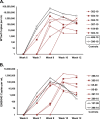Influence of mismatch of Env sequences on vaccine protection by live attenuated simian immunodeficiency virus
- PMID: 23637396
- PMCID: PMC3700272
- DOI: 10.1128/JVI.00798-13
Influence of mismatch of Env sequences on vaccine protection by live attenuated simian immunodeficiency virus
Abstract
Vaccine/challenge experiments that utilize live attenuated strains of simian immunodeficiency virus (SIV) in monkeys may be useful for elucidating what is needed from a vaccine in order to achieve protective immunity. Derivatives of SIVmac239 and SIVmac239Δnef were constructed in which env sequences were replaced with those of the heterologous strain E543; these were then used in vaccine/challenge experiments. When challenge occurred at 22 weeks, 10 of 12 monkeys exhibited apparent sterilizing immunity despite a mismatch of Env sequences, compared to 12 of 12 monkeys with apparent sterilizing immunity when challenge virus was matched in its Env sequence. However, when challenge occurred at 6 weeks, 6 of 6 SIV239Δnef-immunized monkeys became superinfected by challenge virus mismatched in its Env sequence (SIV239/EnvE543). These results contrast markedly not only with the results of the week 22 challenge but also with the sterilizing immunity observed in 5 of 5 SIV239Δnef-immunized rhesus monkeys challenged at 5 weeks with SIV239, i.e., with no mismatch of Env sequences. We conclude from these studies that a mismatch of Env sequences in the challenge virus can have a dramatic effect on the extent of apparent sterilizing immunity when challenge occurs relatively early, 5 to 6 weeks after the nef-deleted SIV administration. However, by 22 weeks, mismatch of Env sequences has little or no influence on the degree of protection against challenge virus. Our findings suggest that anti-Env immune responses are a key component of the protective immunity elicited by live attenuated, nef-deleted SIV.
Figures










References
-
- Desrosiers RC. 1999. Strategies used by human immunodeficiency virus that allow persistent viral replication. Nat. Med. 5:723–725 - PubMed
-
- Chohan BH, Piantadosi A, Overbaugh J. 2010. HIV-1 superinfection and its implications for vaccine design. Curr. HIV Res. 8:596–601 - PubMed
-
- Daniel MD, Kirchhoff F, Czajak SC, Sehgal PK, Desrosiers RC. 1992. Protective effects of a live-attenuated SIV vaccine with a deletion in the nef gene. Science 258:1938–1941 - PubMed
-
- Johnson RP, Lifson JD, Czajak SC, Cole KS, Manson KH, Glickman R, Yang J, Montefiori DC, Montelaro R, Wyand M, Desrosiers RC. 1999. Highly attenuated vaccine strains of simian immunodeficiency virus protect against vaginal challenge: inverse relation of degree of protection with level of attenuation. J. Virol. 73:4952–4961 - PMC - PubMed
Publication types
MeSH terms
Substances
Grants and funding
LinkOut - more resources
Full Text Sources
Other Literature Sources

